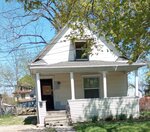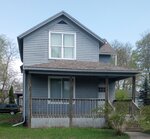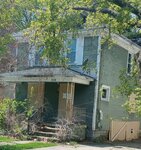




















Dan Backus thought that investing in rental properties in 1978 would serve as a retirement plan.
“I was thinking long term,” said Backus, 76, a retired building contractor from Mason about why he bought three Lansing rental properties.
But the reality of being a landlord has turned out much differently, at least at 123 Isbell St., near Washington Avenue in Fabulous Acres, a working-class neighborhood. He and his wife, Mary, bought it in the ‘90s, with the goal of returning it from being two units to a single-family house. Meanwhile, he rented it as was.
But on Halloween 2003, the city red-tagged it — meaning it was declared uninhabitable — after an inspection revealed nearly two pages of housing violations, ranging from a lack of smoke detectors to structural issues with the foundation and the roof. While Backus worked on those issues, he said, a pipe froze and burst. The subsequent flood washed through the home, destroying ceilings and flooring.
City property records do not show any current permits for construction or mechanical improvements for the property. On the front window is a building permit that expired in 2005.
Those records also show that Backus has had problems with the city over the years with his other two rentals, which are nearby. But it’s 123 Isbell St. that stands out: It is the longest red-tagged property in Lansing. It’s been red-tagged for nearly 20 years. It is emblematic of what city officials call a housing crisis.
As of May 8, the city had 685 red-tagged properties, according to a report adopted by the City Council. Of those, 501 are being monitored by the city and charged a $150-a-month fee.
Twenty-one have been red-tagged for a decade or more. A red tag means the residence has been deemed unsafe to occupy.
The city also has 281 pink-tagged buildings, which which means a property has code-related issues that do not cause an immediate threat to health and safety if a person continues to live in the property. However, if that tenant moves, the landlord is prohibited from renting until the pink tag is removed.
“There is a crisis of not having enough affordable and safe housing,” Lansing Mayor Andy Schor told City Pulse in an interview after an April 3 special meeting of City Council’s Committee of the Whole. The meeting was called to address housing issues following a series of high-profile red-tag-related evictions.
“When you hear that if we’re gonna red tag these properties and displace people, there’s nowhere for them to go,” Schor said, “that’s a crisis.”
It’s a sentiment shared by administration officials and City Council members.
“Yes, there is a housing crisis in the city of Lansing and our region,” said At-large member Peter Spadafore. “This red-tag, pink-tag, unsafe-housing-condition factor is a huge part of it.”
The housing crisis is a combination of a swelling population of homeless residents, an aging housing stock, a lack of attainable housing — that is, housing that is below market rate and accessible financially to those who do not qualify for low-income housing options — a dysfunctional Code Compliance Office and unscrupulous landlords who ignore, manipulate and violate the city’s housing laws.Houses like 123 Isbell feed a negative cycle, causing property values to decrease and neighborhoods to struggle to keep the area safe, said First Ward Councilmember Ryan Kost and At-Large Councilmember Carol Wood. The Isbell property is in the First Ward.
Kost has raised the alarm about people living in red-tagged housing and the general condition of Lansing’s housing stock. Those alarms have resulted in turmoil, resignations and retirements in the city’s Code Enforcement Office.
On April 3, the City Council held a special, four-hour meeting after housing issues culminated in a series of evictions from red-tagged residences and a lack of housing to move people into. Administrative officials were put on the hot seat to explain why people were living in substandard conditions.
That’s when the Council learned there were 21 properties in the city that have been red-tagged for a decade or more, led by 123 Isbell.
From the street, it is a well-appointed one-and-a-half-story home. The lawn is cut. There are flowers growing in the flower beds. But behind it, a pile of logs from a fallen tree is stacked haphazardly. There are multiple trailers with tarped-covered appliances in them. Some have flat tires, which could result in premise violations. The front porch had three gasoline containers and a pile of scrap wood on it.
Backus showed off the renovations he has accomplished in the home over the years. He’s replaced the flooring and drywall. There’s new electricity throughout the house. He added support beams in the living room and the basement to shore up the floors, which he described as “a little bit on the bouncy side.”
As for the lengthy time the property has remained tagged, he admits he’s “guilty.” Other priorities, including keeping up his two other properties — a total of eight apartments — have taken over. The city’s fee of $150 a month to monitor the property to verify it remains uninhabited and secured didn’t bother him. He figured he’d spend that on rental fees for a storage unit to store tools that he keeps at the house.
A property owner has 90 days to begin taking action to resolve the property violations before the city starts charging the monitoring fee. Those actions could include getting required permits, as is required for items like electrical work, construction and remodeling or installation of new furnaces or water heaters. That means that of the city’s approximately 700 red-tagged residences, over 500 — or more than 73% — have been deemed uninhabitable for at least 90 days.
Jordan Hankwitz is the newly appointed director of the Economic Planning and Development Department, which oversees the Code Compliance Office. That office is responsible for inspecting and monitoring the city’s housing stocks.Hankwitz said he would classify the house at 123 Isbell as being “in limbo.”
“If we don’t have the mechanisms for escalation to get it out of our pot and they’re paying the fees, what do we do? We’re a little stuck,” Hankwitz said.
As a result, his department is studying fees charged to landlords “to make sure that these fees are appropriate for compulsion. We want people compelled to act.”
The monitoring fee has not been reviewed since it was implemented in 2005.
That might be difficult, though. Michigan law requires that municipal fees cover only the actual expenses incurred for a given service.
In a wide-ranging interview, Hankwitz talked at length about looking at the city’s policies and procedures. It’s going to be a learning curve for him and his deputy, Nicholas Montry, because neither has a background in housing matters.
Hankwitz, 38, joined the city last month from the state Legislature, where he spent eight years as the Senate’s chief financial officer in the nonpartisan Senate Business Office. He holds a bachelor’s degree in political science and an MBA from Michigan State University.
Montry, 44, also joined the department in April from the city’s Public Service Department. He’s been there for nearly five years as an engineering technician supervisor. In that post, he reviewed utility construction permits throughout the city. Before joining the city, Montry ran a small business for 15 years. He holds a bachelor’s degree in business management from Northwood University. He also holds an associate degree in business administration from Lansing Community College.
Hankwitz and Montry will in particular be trying to get a handle on how the Code Compliance Office operates and how big a part of the housing crisis it is.
The office has had nine building inspectors; three premise officers, who enforce the grass and trash code; three clerks; one administrative secretary; and a manager. One inspector is on leave. Code Compliance is up one inspector and one premise officer since Schor became mayor in 2018. Previous departmental leadership has said the current staffing level is enough, administration spokesperson Scott Bean said. But with new leadership that may change.
“That’s part of the review that Jordan and Nick are doing as well as finding other efficiencies where possible,” Bean said. It remains unclear when the duo will complete their top-to-bottom departmental assessment.
The Council approved the two new positions after complaints from citizens that the office was not responding fast enough. One inspector was moved to inspecting the business corridors, allowing the others to focus on neighborhoods.
Kost said the two new positions haven’t “made a dent in the problem.” But he said he will wait until Hankwitz and his team complete their review before determining if more staff is needed. The implication is that the problem may not be the size of the staff but its performance.
Each inspector is slated to inspect 16 single-family properties a week. Those same inspectors are also weaving in inspections on multi-family apartment complexes, which can take days or weeks to fully inspect.
Single-family homes are being inspected as quickly as seven days after the fees are paid, said Bean. Multi-family units are waiting six to eight weeks.
One apartment complex made headlines this winter because of its living conditions. The city is battling with the owners of Autumn Ridge Apartments and Townhomes, OPV Partners LLC of Southfield, for years. Of 618 units in the sprawling complex on the very southern edge of the city, 27 are red-tagged.
The owners claimed enforcement of the city’s codes were being applied in a racist way — but that lawsuit was dismissed on agreement between the company and the city. The company has since filed appeals related to findings from code compliance inspections that required significant work to qualify for rental certification. Those appeals are ongoing, but the property remains problematic.
Bean said the city wants owners of Autumn Ridge “to stop playing games and get the property up to code and into compliance.”
“This has gone on for far too long, and these property owners have gotten good at gaming the system. The residents of Autumn Ridge who get caught in the middle need safe housing that meets state and city standards.”
Last month, Schor and his administration spent a Friday evening fighting to get natural gas service restored at the property. The reason it was turned off? Property owners had failed to pay the Consumer’s Energy bill. Schor was able to get the company to restore service.
OPV Partners is one of many headaches for the city when it comes to providing safe housing. The city is suing Richard and Brad Simtob, Holmes Apartments LLC, The Good Life Apartments LLC and Simtob Management & Investment LLC. Each of the companies is tied to the Simtobs, City Attorney Jim Smiertka told City Pulse May 2, when the city filed the lawsuit.
The companies and the Simtobs have been in hot water since building officials found the Holmes Apartments, 222 W. Holmes Road, were uninhabitable because the owners failed to make roof repairs. The roof was damaged in heavy winds in 2022, leaving the building open to the weather and creating a fire risk. Residents had taken to social media to express their anger and concern for the state of their units. Those social media posts included photographs showing holes between the floor and ceiling of two units.
The company agreed to re-house the residents, but it moved them to Pacific Apartments, 1317 E. Kalamazoo St., until city officials learned those units were pink-tagged. The displaced residents were moved to local hotels and the city was footing the bill. In court two weeks ago, the companies agreed to reimburse the city for the hotel bills and pick up the continuing tab. They also agreed to get building permits and secure the building.
The city has paid $10,091.78 to house nine people in six hotel rooms from the Simtob situation. The Simtobs and their constellation of LLCs are reimbursing the city and taking over payment of the hotels until the properties are brought up to code, Bean said.
Bean declined to discuss the Simtob lawsuit because it was in litigation. In general, however, he said the city “will continue to use every tool available, including the courts, when landlords have tenants living in substandard conditions.”
Standing in the backyard of their Mason home, Mary Backus, the co-owner of 123 Isbell, said being a landlord was difficult.
“Everybody is on some kind of assistance or some Social Security, things like that. They’re not people that have any place to live, and he’s trying to provide that for them,” she said of her husband. “But it’s hard to keep up with them. Because a lot of them aren’t very clean and they just have no regard for any of the stuff that he’s done. You know? It’s tough being a landlord.”
Working with “low-income” residents also causes a cash flow issue for the elderly couple. “I mean, he’s really getting on it and trying to get it done,” she said.
Her husband shared his frustration about the Ingham County Land Bank property across the street, at 118 Isbell. The lot was vacant, and the grass was unmowed. At the back were stacks of tires in one corner of the lot, abutting his property.
“Why is it they are cracking down on me?” he asks with a tinge of bitterness in his voice. “They don’t do anything about this. They really can’t complain about me, but I understand the City Council gets involved and then they’re going to really start jumping.”
The land bank is not subject to the same premise codes as private property owners, said Ingham County Treasurer Alan Fox, the ex-officio chair of the land bank’s board.
“We try to be conscientious about mowing regularly,” he said, adding that the organization mows hundreds of properties a month.
As for the property behind Backus’ property, Fox said the land bank is aware of the ongoing problem of people putting their trash on empty lots. The organization is working to identify those people and have them remove the garbage, he said.
“That’s why we ask people who see this sort of thing to call the land bank offices,” he said. “Often the neighbors know better what is going on than we do.” (The phone number is 517-267-5221.)
Back at 123 Isbell, Backus pointed to the siding, noting that it’s asbestos.
“The city does have programs that you can get new siding,” he said. “I think it’ll qualify. If it doesn’t, I’m sure I got some lead paint here,” which could also possibly qualify him for assistance.
He taps the red tag on the door. “But this means I can’t apply.”
In his State of the City address on March 14, Schor announced an initiative to help landlords improve their properties — in addition to programs that help remediate lead.
“New state laws allow communities to use incentives to update existing rental housing,” Schor said. “I am proud to announce we are putting the final touches on a new Lansing Rental Housing Rehabilitation Program, which will help to rehab affordable rental housing. We will be creating requirements and guideposts for this program to ensure that it is appropriately used and rental properties are improved throughout the city.”
Bean said Monday the administration will release the proposed legislation by the end of May. Earlier, though, the plan was going to be ready by the end of April. City Council will have to review and approve it.
Backus also noted that the red tag serves as an invitation to thieves and vagrants.
“I’ve had all the copper stolen,” he said. “Obviously, they know it’s vacant. I’ve had a couple of different issues with it because of that, but it also stops me from doing anything.”
Red-tagged properties are not going to disappear, city officials said. The city’s housing stock is aging, requiring more work to keep it up, and ultimately some property owners are going to fall behind in doing so.
The question for Wood and Hankwitz is not how many properties are red-tagged, but rather how long have they been in that condition.
“It’s one house at a time, one problem at a time, and at the end of a year you look back and say, we got 20 houses taken care of,” Wood said. “You didn’t realize that when you were doing that one house at a time. Right. But that one house at a time is a critical move for a community and a neighborhood.”
That philosophy is what she will use in her remaining time on the Council — after six terms, she will retire on Dec. 31 — to help determine solutions, one of which is demolition.
It can take years for a property to reach a point where demolition is considered. Each property is unique in terms of the time frame it takes to get there.
Why not just tear them down when landlords are recalcitrant?
Demolishing a property is difficult. State law requires a property either be a blight or that repair costs exceed the state-equalized value of the property. An SEV is half the market rate of a property. Once one or both of those triggers are reached, the city must put the property before the city demolition board, a body made up of three individuals with a background in housing. The board can either send it back to Code Compliance for further attempts to get cooperation from the property owner or recommend demolition to the Council, which delegates it to the Public Safety Committee. After review, the committee makes its recommendation to the Council. If it’s for demolition and the Council agrees, then there’s a public hearing. Then the committee studies it some more. Then, finally, if the committee recommends it, the Council votes on a “Make Safe of Demolish” order. Then the property owner has 60 days to take action to prevent the demolition.
A property owner can take substantial action to stave off demolition at any point through the process. Even after a final demolition has been ordered, the property has to be disconnected from the utilities. That can take as long as six or nine months.
In 2022, 11 properties were ordered demolished. All but two have been.
There is an alternative. Instead of waiting until the property is so damaged and beyond repair that demolition is less expensive than repairing, state law allows a municipality to begin make safe or demolition actions on a property that has been red-tagged over 24 months. However, it is not a provision the Schor administration is using. Bean said they don’t want to tear all the properties down. “We want them repaired.”
Spadafore would like to see the city explore creating a fund that would allow contractors, hired by the city, to enter and upgrade properties that have been red-tagged. Spadafore said it may have to require a special fund or assessment on landlords to pay for such improvements.
“There are some hurdles there, but it sounds like it might be possible to explore,” he said following the April 3 special meeting. “That’s something I’m certainly gonna lean on and figure out if we can do that to make places safer for our residents to be housed in.”
Wood, who has been on the Council since 1999, apologized for the Council’s role in the housing crisis during that special Committee of the Whole meeting. In a sit-down with her, she said that she has not accomplished all she had hoped related to housing issues when she first ran for office. She said the reality of being in the legislative body was a wake-up call. There were limits to their power.
“There’s always more that can be done,” she said. “Council may pass a new ordinance, but that doesn’t mean it’s being enforced.”
As an example, she raised the concern that the city was supposed to refuse to certify a rental property if taxes were due on it. But former Code Compliance Office manager Scott Sanford was not refusing to certify for that reason if the tax debt had been transferred to the county, as happens as part of the foreclosure process. Based on advice from the City Attorney’s Office, Sanford’s argument was that the taxes were no longer due to the city.
Council members said they knew nothing about this policy until mid-March, shortly after Sanford, the butt of much criticism from the Council, quit in frustration over what he considered political games.
The city has since begun declining certification or recertification for rental properties if the owner has past-due taxes due to either the city or the county.
Wood was asked if the housing issues, including red tags, meant the city and the Council had failed. She was blunt. “Yes. We have.”
“The failure was assuming that people were doing what needed to be done, accepting the answers that were given to us instead of asking for the data.”
Sanford called the focus on red tags a “joke.”
“Less than an eighth of a percent of the entire housing stock in Lansing is tagged,” he said.
“The only people that complained about red-tagged properties or properties that needed to be red-tagged were when they had a neighbor they didn’t like. And it became a big dispute. And then they were constantly complaining, you know, if a piece of paper blew in the yard, they were reporting. But other than that, we didn’t really get a lot of complaints about red-tagged properties.”
While the city continues to evaluate the systems in place to improve the housing stock in the city, Backus said he’s ready to let go of his properties.
“I just need to get my stuff out of here,” he said, motioning to his tools in the living room of 123 Isbell. “Then I’m going to sell it all.”
Support City Pulse - Donate Today!
Comments
No comments on this item Please log in to comment by clicking here